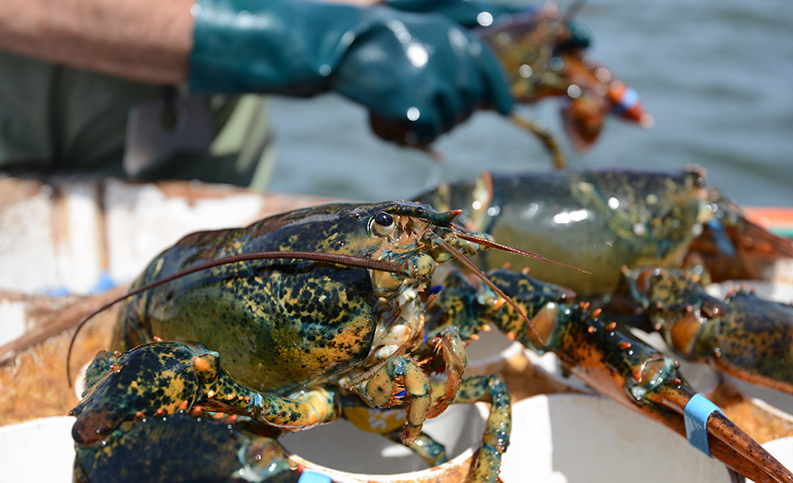My belly full from one too many meat-centric dinners I find myself thinking the Italians are onto something with their seafood-focused Christmas meals. I live in Canada, blessed by three oceans and millions of lakes, I work for the MSC… So why, oh why do I persist with my views that a holiday meal must include turkey or ham? Time to buck tradition!
Immediately I crave lobster – an iconic Canadian product that is increasingly appearing on tables in North America, Europe and now Asia. Sure it’s often viewed as a luxury product reserved for celebrations, but on this cold winter day I can’t imagine anything more satisfying than lobster comfort food: bisque, mac and cheese, pie… Mmmm.
With this in mind, and as one does when you work in the seafood biz, I get curious and do some digging. Where does my lobster come from and can I feel confident it’s sustainable?
What’s your lobster?
There are only a few types of lobster available, each one fairly easy to identify. If you’re cracking into large, meaty front claws, you’re enjoying the highly prized Homarus americanus, also known as Northern or Atlantic lobster. This species is primarily found in the cold Atlantic waters off the coast of Canada and the Northern United States, where it has been harvested for hundreds of years.
Other species include Homarus gammarus, the larger European lobster and the clawless Panulirus cygnus, or West Australian rock lobster.
From poor man’s food to celebrated delicacy
Early accounts depict Aboriginals fishing lobster simply by wading along the shore with spears and hooks. Back then it was a plentiful source of food, also used as fertilizer while the shells served decorative purposes.
It took Americans until the mid-nineteenth century to develop a taste for the crustacean. Prior to this it was so undesirable that servants complained of having to eat it more than twice a week – a plight prisoners had to endure as it frequently appeared in their meals, if not used as fertilizer or fish bait.
Times have changed, and today, in part thanks to clever marketing, global demand is growing as the appetite for this coveted delicacy continues to reach new heights.
Sustaining an important resource
Approximately 55% of the world’s Homarus americanus comes from five relatively small Canadian Atlantic provinces: New Brunswick, Prince Edward Island (PEI), Newfoundland and Labrador, Quebec, and the most productive, Nova Scotia. It is worth over $1 billion CDN making it the country’s most valuable seafood export.
In a conversation with Craig Avery, president of the Prince Edward Island Fishermen’s Association (PEIFA) he proudly tells me that in his family alone three generations have been raised on a single fishing license. “Sure we also fish some mackerel, herring and a little groundfish to supplement during the down season, but lobster has always been the mainstay. It’s the one you waited for to pay the bills”.
Canada has long recognized the value of managing this resource sustainably. We have one of the longest histories of regulation dating back to the 1870s when the very first conservation measure for protecting egg-bearing female was put in place.
Since then, as fishing gear became more sophisticated and effective, Avery says “fishermen took a hold of their own destiny to protect their industry”.
No fewer than 10,000 licensed fishermen work closely with the Canadian Department of Fisheries and Oceans (DFO) to implement some of the most rigorous conservation methods. They are all tailored to the 45 unique lobster fishing areas and include:
- Limits to the number of fishing licenses
- Limits to the number of traps
- Limits to the length of fishing seasons and number of fishing days
- Limits to total allowable catches
- Minimum size restrictions
- Use of biodegradable twine on traps to avoid ghost fishing when a trap is lost.
Certification and healthy stocks
In another remarkable demonstration of widespread collaboration, from 2009 to 2015, fishermen, processors and other industry players came together to ensure that 97% of all Canadian Atlantic lobster successfully achieved MSC certification.
When asked about the motivation for certification, Avery explains: “I’ve travelled all over the world promoting the Canadian crustacean from Prince Edward Island. Everywhere I go people want to know that your lobster will be available five years down the road. They want to know that the resource is sustainable. It’s crucial for us to stay competitive on the world market and MSC certification signals to our customers that we care about the future of our resource.”
So what of the future of Canadian lobster? Like they say, the proof is in the pudding. According to DFO, lobster harvests have seen an upward trend over the last few decades and remain at one of the highest levels in 100 years. While there are likely multiple reasons for this increase, one thing is for sure: sustainable management cannot be discounted.
You can be sure that you’re tucking into one of these sustainable delicacies by looking for the MSC ecolabel.
Cook and eat like a pro
If you’re like me and an early January craving is reason enough to dig in, here’s one cooking tip from Avery you won’t want to skip. After boiling your whole lobster in salt water give it a dip in a cold, 4% salt water bath then let it rest for 5 to 7 minutes. This will help prevent overcooking and the meat will come right off the shell.
And if you’ve never had the pleasure of eating a whole, fresh lobster using only your hands and a lobster pick, there may be no better place to experience it than in the coastal communities of the Canadian Maritime provinces. Here, the lobster is fresh off the boat, sustainable and the famed East Coast hospitality will have you wishing you never had to leave.
Bon appetit!

